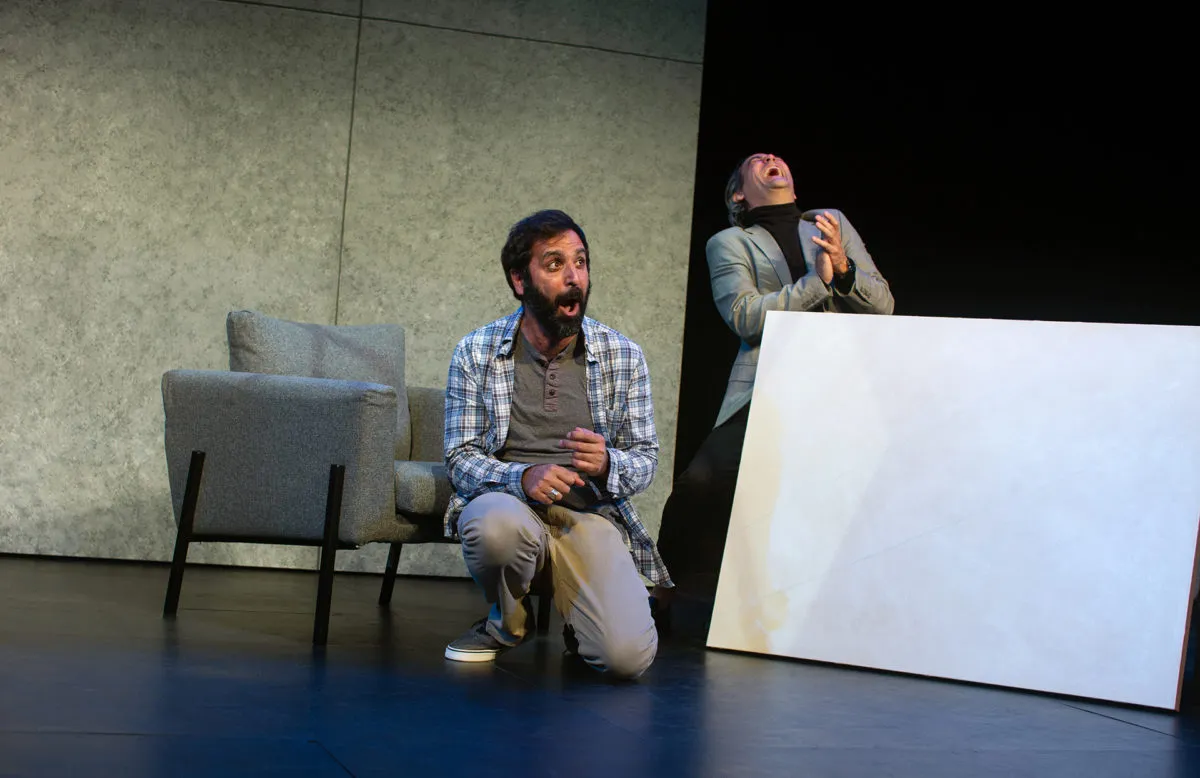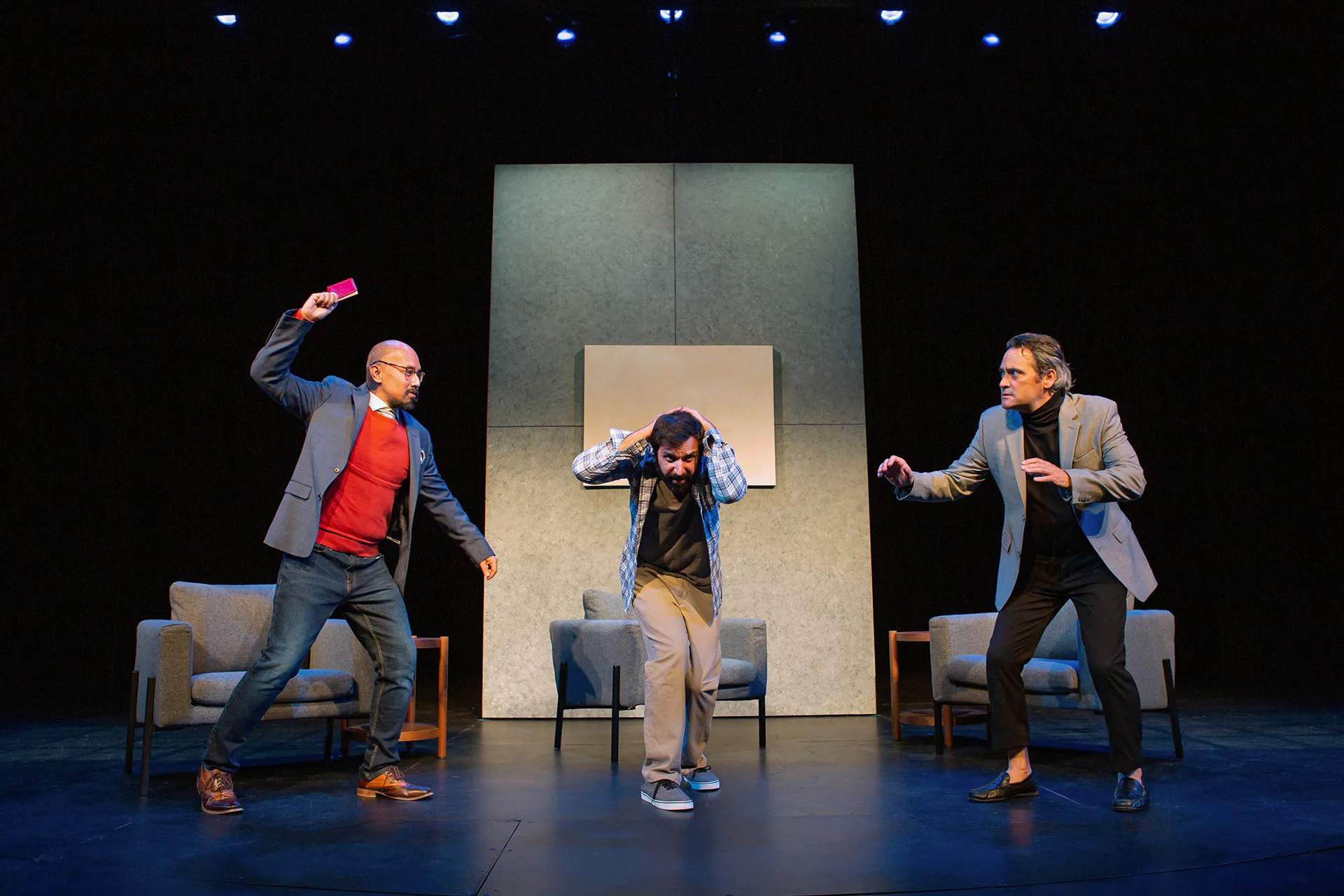SF Playhouse makes a triumphant return in its premiere production of the 2020-21 season with Yasmina Reza’s 1998 Tony Award-winning play “Art,” translated by Christopher Hampton (originally in French) and directed by SF Playhouse artistic director Bill English. As a Bay Area theater that often brings new plays by both emerging and established playwrights to its cozy stage, SF Playhouse makes a bold choice by bringing this more than 25-year-old play to life in a recorded production performed in its original form at the Playhouse theater (but with no audience), shot from multiple camera angles and cut together as a video. However, Reza’s show is, of course, tried and true — and buttressed by three actors with performances sharp enough to cut across the virtual screen. “Art” pulls more than its weight as the first show of SF Playhouse’s ambitious nine-show season.
Since SF Playhouse’s “Mary Poppins,” I haven’t seen an SF Playhouse production in nearly two years (that’s two years!) — partly on me and partly because of the pandemic. (I do miss being able to snack in the SF Playhouse theater, one of my favorite characteristics of the theater, itself tucked into the back and top level of the Kensington Park Hotel just north of Union Square.) But armed with my trusty family-size bag of chips, I was ready for all of the SF Playhouse shine that I know and love.
My first Reza play was the 2009 Tony Award-winning “God of Carnage” at Jeff Daniels’ Purple Rose Theatre in Chelsea, Michigan. “God of Carnage” is an absolute cutting, satirical lambastation of grandiloquent parents, revealing an underlying savagery in their fight to preserve their already six-feet-deep reputation in the playground of the only required locale, a living room set (spoiler: it’s so that one of the characters can puke on everything). It’s ghastly and amazing.
Only Yasmina Reza can turn the simplest things into complex meditations on life that, by the end, ultimately turn back around to laugh in your face. In “God of Carnage,” a dispute between two sets of parents over their children fighting launches them into vicious attacks on their character and sanity; in “Art,” a white painting (or, as the characters argue, a “white” “painting”) breaks friendships and brings characters to tears. Where you thought there was a profound message, Reza undermines it with a childish fight that evokes feelings reminiscent of the brain-poke-esque COVID-19 test nasal swab (to describe the sensation in the most of-the-times way possible). It’s neither a comfortable nor uncomfortable feeling, but it’s definitely some kind of feeling.
In “Art,” Reza takes her time skewering the oft-perceived conception of modern art as highfalutin while doubling back and making a case for it. Dermatologist Serge (Johnny Moreno) buys a $200,000 painting by a famous artist of what appears to be just a white canvas — with some diagonal white stripes (like that “Look, I drew a polar bear in a snowstorm!” kind of joke you might have heard when you were little). His friend Marc (Jomar Tagatac), an aeronautical engineer, immediately scorns him for this absurd purchase while his other friend, textile-turned-stationery businessman Yvan (Bobak Bakhtiari), is caught in the middle.

As the play starts out, with every turn audiences are swayed toward Marc’s side, then Serge’s — and then you realize it’s not about that: It’s actually about how people treat each other when they interpret life differently and can’t understand each other despite 15 years of friendship. Then Reza twists the knife again and again until the argument over the painting gruesomely (metaphorically) peels away the scabs of hurt between the friends: Yvan’s long-standing hesitancy to go through with his upcoming wedding, Marc’s sense of pride founded upon Serge’s admiration, Serge’s insecurity over an identity he’s constructed for himself. Finally, Reza goes so far beyond the characters themselves and into the foundations of how we exist only how others conceptualize us, while simultaneously telling audiences that these philosophical musings are, honestly, nonsensical and only serve to exacerbate the sheer, pitiful depths of human cruelty.
“Art” has no singular takeaway and will do something different for every viewer, but for everyone, it should take on Reza’s signature sense of uncomfortable quality that you can’t quite pinpoint. You want to laugh, you know you can and you know you should… but something’s holding you back. There’s something almost too close to home, that kind of theatrical tension that grips you by the shoulders and squeezes. However, this is also why it works best with a live audience; you’re able to share in this palpable tension with others in the room, picking up on every crackling moment.
SF Playhouse’s “Art” lost a bit of spark translating to a recorded format, but any cast performance less than what the show’s three actors brought to the table could have rendered the show much less than it was. The small but stellar cast truly bolstered the production, never missing a beat. SF Playhouse excels most in its straight plays, bringing together intimate performances with slick and production design (some that will make you think, “Whoa, I can’t believe they built that!” but it’s never flashy), and “Art” exemplifies this as well. The play features a simple yet effective design that shows off what the theater has to offer without spending too much on a set that audiences won’t be able to enjoy in person. On the relatively sparse stage, the set merely consists of a side table, a few chairs and a spinning three-sided contraption in the back that acts as each of the characters’ apartment/home back walls rotating to each character’s corresponding side depending on the location. Each location is denoted through color palette and style (complemented by lighting design by Heather Kenyon).
At certain comedic turns, I was practically waiting for the audience to laugh — being so used to that timing, I heard a little audience laugh in my head every time that happened. Due to the digital format, the laughs just don’t hit as hard (especially the fits of laughter that punctuate the play) despite the genuinely comedic nature of “Art.” Nonetheless, viewers will quickly get absorbed in the fast pace of the show, seamlessly held up by the three actors. Moreno stands out as the unflinching owner of the white painting, his voice imbued with a small lilt that carries an innately sardonic tone that feeds perfectly into his character’s interrogatory lines of questioning toward Marc and Yvan. Bakhtiari brings the needed quirk to the play with his performance of the authentically and amusingly messy Yvan, caught between a fight between two close friends in which he ultimately ends up as the punching bag; the standout part of the play includes an extraordinary four-and-a-half-minute monologue where Yvan reenacts a conversation and acts as three people at once (himself, his mother and his fiancée) as he tries to make an excuse for why he’s late. Last but not least, Tagatac is yet again a pleasure to watch as the scornful, self-righteous yet fragile Marc (including a personal favorite performance in Bay Area playwright Christopher Chen’s political-thriller-for-the-stage “You Mean to Do Me Harm”).
As SF Playhouse (presumably) moves forward with more filmed-for-the-stage plays, my wish list remains small but still pressing especially given the theater’s already all-around high standards for production quality. Some of the more abstract sound design laid on top of the video that would have otherwise worked in a theatrical setting felt unnatural and distracting, while the musical elements that settled under the dialogue set the tone well. I also wished the scene transitions showed the whole stage. Often, the magic of theatrical transitions (especially at SF Playhouse) is in watching them work and watching the stage take form before our eyes; they are an art in and of themselves. The video quality wasn’t superb, with some jerky camera movement and out-of-focus moments, but the tempo of the editing and cutting made up for the energy lost from its translation from stage to screen.
Preserving the most essential parts of what SF Playhouse brings to the Bay Area theater scene, “Art” is a welcome offering, and I’m looking forward to what the theater brings to life next. Reza’s play is the sort of makes-you-question-your-sanity type of play that captures what you might be feeling at this time — but at least once the play’s over, that feeling doesn’t stay with you in a bad way. “Art” at SF Playhouse is currently streaming online through Nov. 21. If you’ve been hungry for theater like me and need a few laughs or a breath of comedic fresh air, visit the “Art” production page here to learn more and get pay-what-you-can ($15-$100) tickets.
Contact Olivia Popp at oliviapopp ‘at’ stanford.edu.
